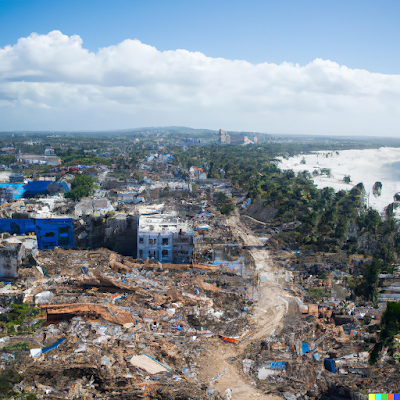How to Evaluate the potential INDETUR?
PREAMBLE
The Dominican Republic’s National Institute for Planning in Touristic Areas (INDETUR) is still uncertain. Nevertheless is necessary to think that after its possible establishment the relationship conditions between public sector, private sector, civil society and communities will change.
The content presented here is a summary of the Terms of Reference (ToR) design for an INDETUR’s Evaluation after its launching.
The full report was made for the “Project Monitoring and Evaluation” course, within the Master Urban Development and Reconstruction 07/08 at the IUAV University in Venice.
INTRODUCTION
Dominican Republic is the most important touristic destination in the Caribbean. The 20% of the economy rely on tourism, and probably the trickle down effect turns it into 36%. This value involves formal and informal economy. A boom in residential project building and real state has taken place in certain areas, especially the east and northeast, with millions of dollars allocated for exclusive private development.
Due to history and centralization, the macro-level planning is carried out by the Ministry of Tourism, who is greatly in charge of regulating land use and project approval within the areas declared as touristic by law. Other Ministries or Public offices involved in the process are: Municipalities (at times very rudimentary), the national coordinator for Municipalites (Liga Municipal Dominicana), and Ministry of Environment.
In recent years new changes have occur aiming at reorganizing the planning structure for the country. A new Ministry of Economy, Planning and Development have been created merging existing offices, and its interaction with other ministries is to be improved in the following years.
As an innovative initiative, a new Institute for Planning in Touristic Areas (Instituto Nacional para el Desarrollo Turístico, INDETUR) was proposed, and is now actually under final revision before approval by the Congress. This Institute would bring together the private sector into the planning process, as well as other Ministries and the National Water Agency. ASONAHORES (National Association of Hotels and Restaurants) and the National Association of Touristic Real State and Developers’ represent the private sector.
Even if some problems could begin, the public-private partnership proposal theoretically should bring improvements not only in the development of infrastructure for hotels, but also for the communities supporting the functioning of the tourism industry.
The evaluation is to be carried out as an on going evaluation after the establishment of the Institute (formative evaluation type). The evaluation results can be then related to the public priorities and be compared within the national wage/expenses, within a period of time (summative evaluation type).
Evaluation Purpose
Recognizing the importance of tourism, this evaluation will provide the new INDETUR, the central Government and the society with the improvement data from the touristic areas’ communities in order to make the appropriate changes to the Institute and its relationship with other institutions and all the stakeholders.
Evaluation Questions*
* The indicators for each evaluation questions are listed in the complete design report.
Evaluation questions on:
Improvement on projects regularization and urbanization issues
1. To what extent the INDETUR improved the approval of projects?
2. To what extent the INDETUR produced or revised the touristic development plans and standards?
Public-private partnership interaction
1. To what extent the private and public sector are sharing the Institute’s responsibilities?
2. To what extent minor private entrepreneurs can participate in the Institute decision-making process?
Budget allocation
1. To what extent the Institute is favoring the least developed clusters?
2. To what extent the Institute is investing in compulsory infrastructure?
Communities’ involvement and life quality improvement
1. To what extent people and communities are being involved?
2. To what extent the quality of life has improved in each cluster?
METHODOLOGY
Sources
The primary data collection instruments and techniques are the following:
1. National and municipal government data from:
a. Ministry of Tourism
b. Ministry of Economy, Planning and Development
c. Municipalities
d. National Statistics Institute
e. Private and Civil Society Associations
2. Household surveys
3. Institute’s user surveys
4. Structured interviews and focus groups
Methods and Procedures*
* The full description of methods and procedures is available on the complete design report.
The national and municipal data will be gathered and should record the figures since the establishment of the Institute until the end of the evaluation process.
The household surveys will be carried in the regional clusters, stratified in two strata:
i. on site population/ supporting communities (OnSP/SC)
ii. neighboring communities and settlements (NCS)
The first baseline survey will establish the socio-economic conditions of the inhabitants and villages against which subsequent changes can be evaluated. The survey should give the complete profile of the sampled villages with gender-disaggregated data.
Sampling Conditions
Confidence degree 95%
Precision 5%
DATA ANALYSIS*
* The full description is available on the complete design report.
RESULTS REPORT AND COMMUNICATION STRATEGY
The evaluation results shall be reported in three levels:
i. First Mid-Term Report
ii. Second Mid-Term Report
iii. Final Report
The Mid-Term Reports will be addressed to:
· INDETUR’s Members and Personnel
· Ministry of Tourism
· Ministry of Economy, Planning and Development
· Municipalities
· Civil society organizations
These reports will be progress-oriented, and should provide summaries of principal findings, qualitative and quantitative descriptions of socio-economic changes and comments on the evaluation process itself.
The Final Report shall be addressed to the Institutions mentioned previously. This report should be comprehensive and shall assess the extents of the changes and the society-institutional framework analysis. It shall also include comments and conclusions regarding the establishment of INDETUR.
A non-technical summary of the Reports shall be written for the general public and openly distributed. These would be named Popular Reports and shall be available at the same time of the Mid-Term and Final Reports.
The Popular Reports shall be available online.
TIMETABLE*
*The Timetable and evaluation plan is available on the complete design report.
ANNEXES*
1. Cluster’s Map
2. Household sampling assessment
3. Baseline bibliography
*All Annexes are available in the complete design report.
Cluster’s Map



Comentarios